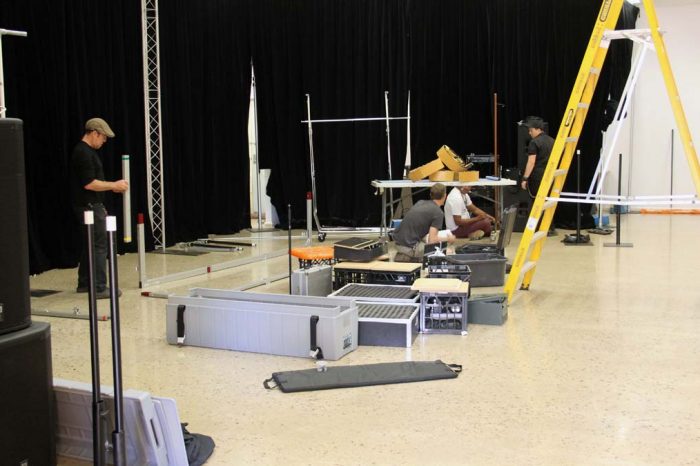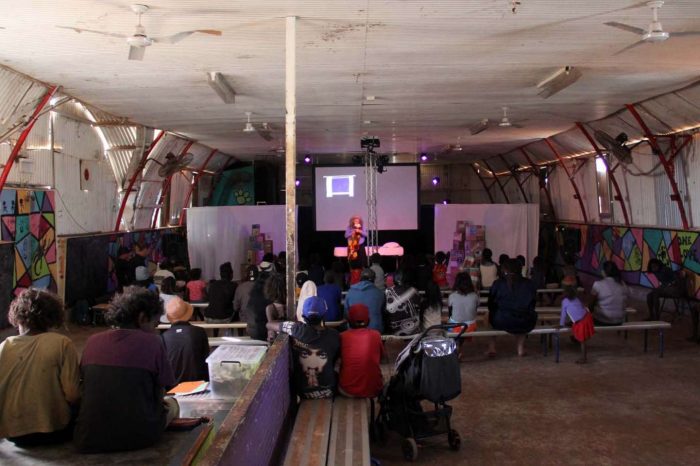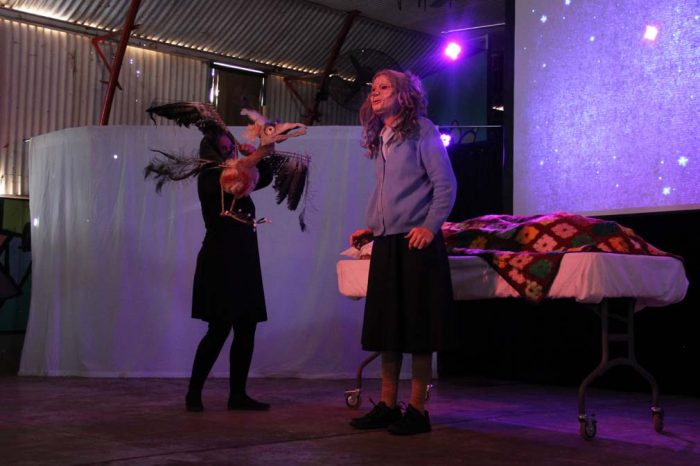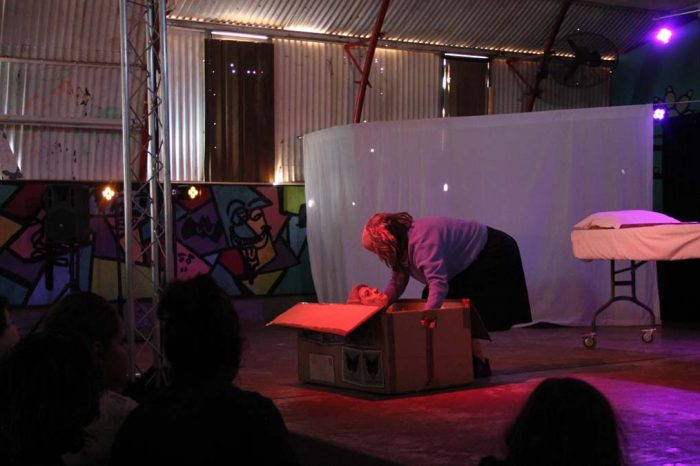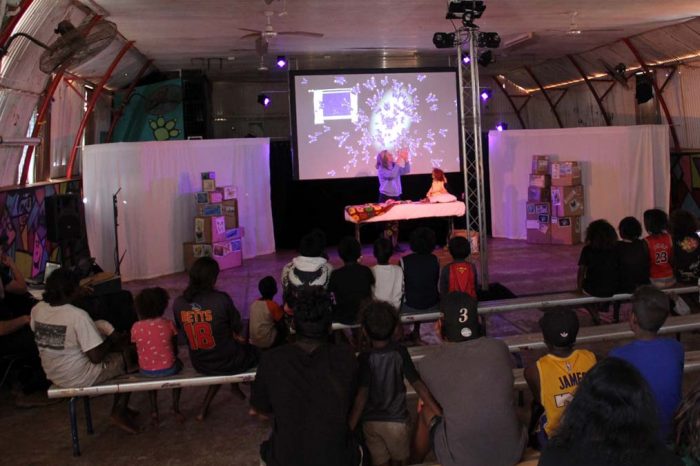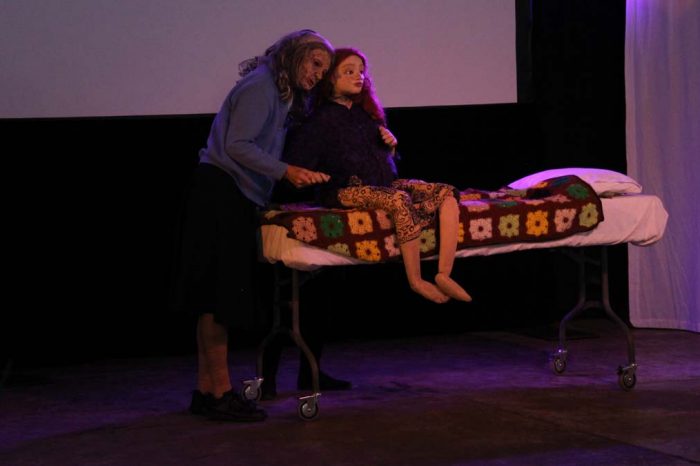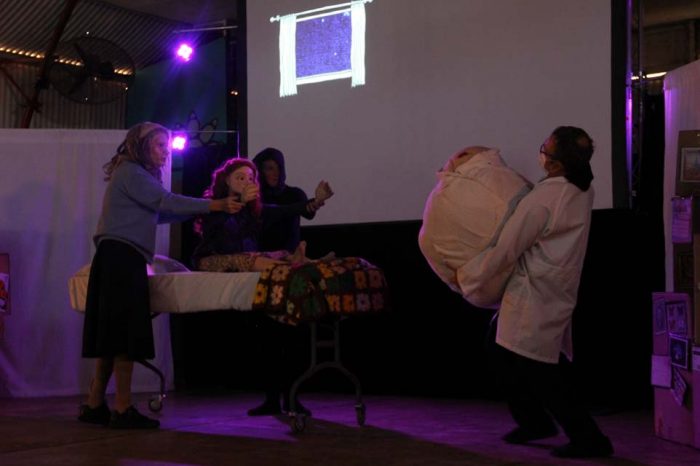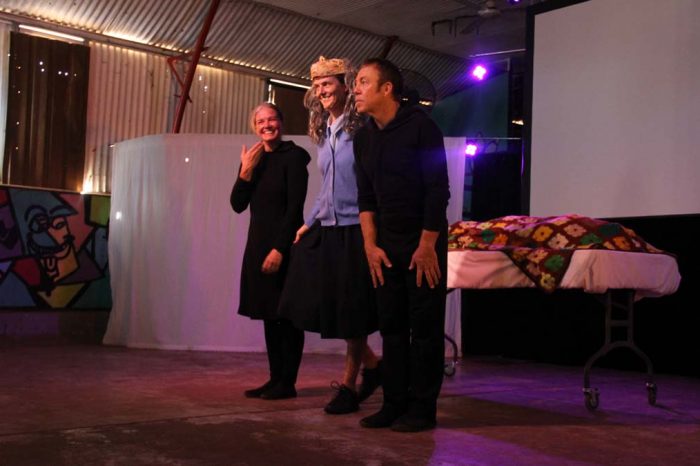On the road with Packed Theatre as they unpack their latest tour …
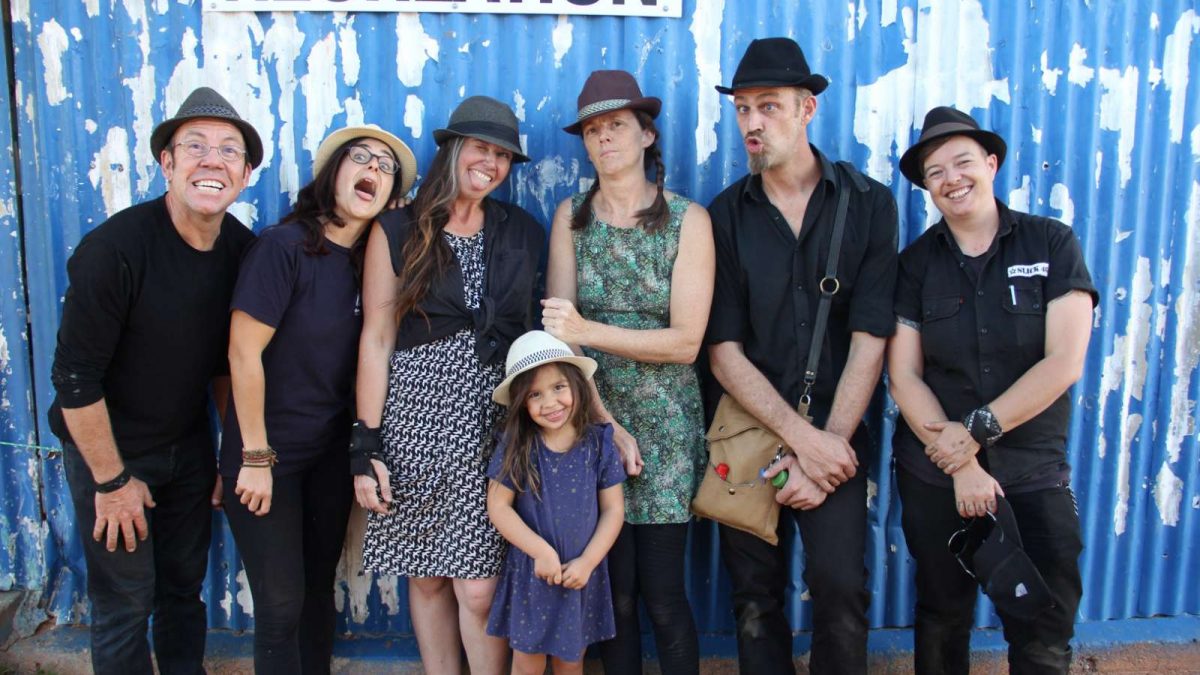
Packed Theatre is an ensemble of Northern Territory artists whose work takes family audiences on uplifting, soulful journeys of magical realism, addressing socially-hidden subjects with beauty, humour and great heart.
Combining puppetry, physical theatre, animation, and mask, Katelnd Griffin and Robbie Hoad co-devised and perform in an incredible show called The Package with Rosie Wild which uses the language of gesture, image and imagination to tell stories wordlessly.
Creating work that’s somewhere between a well-loved picture book and a dream, The Package reaches across ages, cultures and language-barriers to go straight to the heart. Here, Ktima Heathcote, acting Communications Manager caught up with all three at the end of a two-week tour with Artback NT through the Northern Territory, which took them to Alice Springs, Palmerston, Katherine, Elliott, Tennant Creek and Ali Curung.
How was the recent tour of the Northern Territory?
Rosie: It was fantastic. What stood out to me was how much the show captivated people. That bush kids and audiences everywhere were spellbound by the show and really loved it. It was a great reaction, very affirming for us.
What were the highlights?
Rosie: Two things. One was performing to 100 or so schoolkids in Katherine and the incredible responsiveness of that audience to the show. The other, questions and answers, workshops with young people and noticing what a wonderful tool puppets are for people to engage with in terms of theatre and exploring story. The youth workers all said, “yeah we’re going to use this now – it’s a new tool for us”.
Robbie: Yeah, the Katherine show was awesome. It was really good because there are clown elements. A couple of the scenes use a basic kind of clown and the kids responded to that well. What was also special was seeing the reactions of kids in the communities we visited who don’t get exposed [to performance]. They don’t see live theatre and they loved it. They absolutely loved it.
The other highlight for me was the crew; such wonderful people. Lirio [Katelnd’s daughter] was central, and particularly the relationship between our lighting technician, who’s 6ft 7, and Lirio. They were a clown show in themselves. We all had so much fun. We made jokes all the time and laughed at each other.
So there was a lot of laughter?
Rosie: Just vocally, there was so much laughter coming from all the audiences. And then because it’s a wordless show the younger kids, in particular, are figuring it all out and talking between themselves about what’s happening on the stage, like “how do two people come out of that one box?”, “what’s the bird doing?” and “ah, that old person is the same”.
Robbie: It was like hearing their brain. By talking amongst themselves we got to experience in real time their minds ticking.
Katelnd: Yeah, they expressed their reactions all the time. Prior to this tour we’d only really performed the show in black box theatres with adult audiences who are very respectful and quiet and clap at the end but you don’t know what they’re experiencing. Kids are beautiful in that way, they let it all out the whole time as they’re figuring things out.
What was the inspiration behind The Package?
Katelnd: I had some ideas in 2013 which were inspired by my experiences as a junior doctor dealing with elderly patients dying in the hospital and the way that they were. They came in sometimes from nursing homes and they had already become quite unwell so they couldn’t speak. In the hospital it was a little bit about caring for the body but not knowing anything about the mind or the memories or stories that made that person; that had made up their lives. It was in response to this that I came up with the basic concept and a few characters and ideas for scenes. I put together some music and then Robbie and Rosie joined me and we devised the original show together along with Unanytji Scales.
How has The Package evolved since the premier at the Alice Desert Festival in 2014?
Rosie: It’s evolved every time we’ve performed it and there’s a mix of reasons. Part of it is responding to what’s working well or evoking strong emotional connection for audiences. We asked for a lot of feedback in early showings. Another reason is literally having more time to work on things. We might, for instance, have had a seed of an idea but then you have a deadline, you have to put the performance on and it takes a certain time to say fix a puppet or develop the animations or create the shadow puppetry. So it’s a combination of having time and checking in with audiences to see how the story is connecting.
Katelnd: The work is constantly evolving from the seed of an idea to a production. Also, what’s going through our lives at the time we are doing the show. In 2013, I didn’t have a child, in 2014, I was pregnant and now, I have an almost five-year old. The work that Robbie and Rosie have been doing has also probably changed in that time. If you are going into something like this long term you need to have an agenda or something you particularly want to make it mean or get out of it and that changes in the context of our lives. It’s been a long time since we started doing [The Package] so it’s been really great to allow those things to evolve and to grow as we do.
Robbie: We have also had two guest directors over the years. Connor Fox came over from Newcastle to help us with Araluen [Theatre, Alice Springs] in 2015. Araluen has a very big stage. So we had to create a lot more elements to fill that big stage and produce more animation for the show, then, that all that went through some changes. The feedback that came back from audiences at Araluen made us actually change a whole scene for when we went to Adelaide Fringe [in 2017]. The ending, the sort of crisis scene, changed for that show. And then, Karen Hethey came over from Perth in the two weeks before this tour and we completely modified one scene, the essence of it. So those guest directors have brought in elements as have the musicians who have given the show another dimension.
Rosie: There has been a lot of collaboration with the music. There was the three of us involved and three other key musicians, Joaquin Hourbeigt, Annie Pfeiffer and Xavia Nou. We devised something that the musicians really took on board. They refined those concepts and developed them to create a score. We did a crowd funding campaign to be able to record it and through funding from the Northern Territory Government they [the musicians] were able to travel with us to the Fringe Festival in Adelaide for six or seven shows down there.
Robbie: For this tour it would have been too big an entourage to have three live musicians. So the music was recorded and mixed at CAAMA [Central Australian Aboriginal Media Association] studios by Jeremy Conlon.
How did this tour of the Northern Territory come about?
Katelnd: We were at the Adelaide Fringe and there were lots of producers and presenters around. One of the things that came out of all this was we had a chat to Artback NT, who were interested in touring our show throughout the Territory, and in particular to remote communities. So they applied for a grant and got the funding to bring this incredible director from Western Australia, Karen Hethey, over to work with us [Packed Theatre] and organised for us to go on tour. The whole experience was such a privilege because we could concentrate on being artists and developing the show. Normally, we have to do everything.
What makes The Package unique from other shows that use puppets, masks and animation?
Robbie: We have all lived in the Territory for a long time, about 55 years combined, which has given us a unique perspective. But the fact that there is no language is what makes this so special. Being able to create something that doesn’t have language barriers is fantastic. That was definitely Katelnd’s original concept; never any words.
Katelnd: I was inspired by some friends who had a physical theatre company in Europe and they travelled the world with their wordless shows. I thought it was a really beautiful thing which you could share across languages and cultures and I really wanted to make this show the same in the sense that it would be able to be understood by everybody.
Rosie: It helps not having language and having puppetry to engage across lots of cultures and languages. The common humanity that can be engendered by this reminds us what it’s like to be human without being about a specific human. That’s powerful.
What was the response like in the remote communities of the Territory?
Rosie: It was so interesting. When we went out to Ali Curung we heard that the kids were really excited to come see a show, not that any of them had ever seen a theatre show before, and they were like, ‘yeah, we’re coming to see a puppet show, we’re coming to see it’. Then they were like, ‘what’s a puppet?’ It was so new to them, and the sense of wonder and magic that the show engendered was incredible. The feedback we got from the youth worker was that the kids had never been that quiet before or that engaged. So in that sense theatre has the capacity to connect that a movie doesn’t have. It was magical.
Did you face many challenges on this tour?
Rosie: The challenge that we got here which we wouldn’t have if say we were showing on the eastern seaboard was the cultural adaptations that we did. We went through a process of as much consultation as we could on the ground when we got into different places which meant further adapting the show to improve its cultural appropriateness.
Can you give an example?
Rosie: Yeah, there’s a pregnancy scene which audiences in like Alice Springs or Palmerston, where it was predominately white or westernised, considered very powerful. People spoke about it being one of their most potent experiences of the show. But culturally, the pregnancy and the labour scene were too profoundly women’s business to show it to the degree that we had it. So Katelnd spoke with some of the older women.
Katelnd: Prior to the show in Tennant Creek it came out in consultation with the community that the scene where a woman was giving birth would not normally be seen by men or children. So they asked us to not show that, which we didn’t. We have a pregnant puppet and we brought her out instead … and she was obviously in a bit of labour. There was some heavy breathing and she got down on all fours.
After the show a couple of the ladies, who are artists at the art centre in Tennant Creek, told me a friend said they didn’t really want men or children to see that [the puppet in labour] but if it was just women, they would love it. It would be really appropriate. The women would love to see something like that. So the scene still had incredible power and meaning for them as it did for other audiences but they didn’t want men or children to be present when being shown. It is a really interesting potential idea for the future to use in [The Package] as a way to help women talk about pregnancy and childbirth.
Rosie: I want to add to Katelnd’s comment in terms of facilitating conversation about pregnancy and childbirth. I spoke with a midwife about that, too. She was talking about how so many women don’t get supported opportunities to share their birth stories. Lots of people who have had traumatic birth stories might offload on to a midwife but lots of women who have had positive birth stories feel that they can’t share them because they don’t want to shame other women. So there’s still a lot of stigma and tension around speaking about that.
So to use something like this [The Package] is so powerful as a beginning point for well-facilitated conversation. Not just [about pregnancy and childbirth] but exploring the themes of institutionalization, emerging sexuality and approaching death are things that would also be excellent to provide supported conversation about in addition to the show.
How did you change the labour scene?
Katelnd: We changed the way the puppet dressed and went back to basics where she just experiences a little kick of the baby. She doesn’t go into labour and on stage she shares that [kick] with the old lady who’s the central character of the story. She disappears and then comes back with the baby. And the baby is huge. And everybody, all of the kids, the adults, everyone, thought this was hilarious. They really loved this giant baby.
What’s next on the horizon?
Katelnd: I’m having the experiences that inspire theatre.
Robbie: I’m heading to the Top End to teach clown and circus and drama in youth arts with Corrugated Iron.
Rosie: I’m having a week off.

